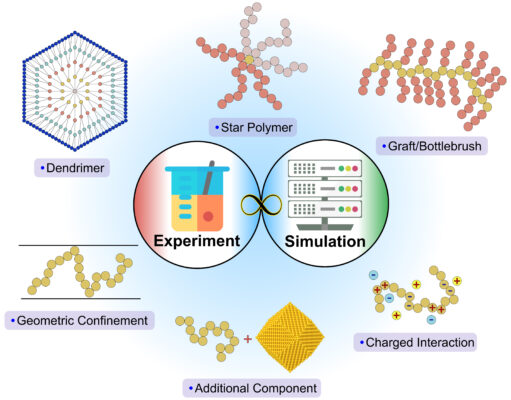A review article titled “Self-Assembly of Architected Macromolecules: Bridging the Gap Between Experiments and Simulations,” authored by Ji Woong Yu, Changsu Yoo, Suchan Cho, Myungeun Seo, and YongJoo Kim, has been published in Chemical Physics Reviews published by American Institute of Physics. We collaborated with the simulation team including Ji Woong Yu at the Korea Institute for Advanced Study (KIAS) as the first author and YongJoo Kim at Korea University as the co-corresponding author. The journal selected our work as the featured article and made it for free to everyone. Check out the following link for the full article: https://pubs.aip.org/aip/cpr/article/6/1/011303/3332377/Self-assembly-of-architected-macromolecules.
Diblock copolymers are the simplest macromolecular architecture and undergo self-assembly in selective solvents to minimize the exposure of solvophobic blocks. In contrast to conventional diblock copolymers, complex macromolecules with nonlinear architectures—such as star, graft, and bottlebrush polymers—exhibit unique self-assembly behaviors due to their pre-programmed, non-exchangeable chain arrangements.
This review emphasizes bridging the gap between experimental and computational approaches in the self-assembly of macromolecules with nonlinear architectures. We discuss experimental techniques for analyzing solution self-assembly, including nuclear magnetic resonance, dynamic light scattering, small-angle X-ray/neutron scattering, transmission electron microscopy, and atomic force microscopy. On the simulation side, we explore various methodologies such as all-atom molecular dynamics, coarse-grained molecular dynamics, dissipative particle dynamics, and field-based approaches.
Furthermore, we provide an in-depth analysis of both simulation and experimental methods for each architecture or complex system, covering aspects such as topological design, synthesis strategies, and self-assembled behaviors from both perspectives. In conclusion, this review highlights the importance of integrating simulation and experimental methodologies to enhance our understanding of the self-assembly of nonlinear architectures, thus broadening the scope of research in advanced materials.

